(599) the legend of St. Valentine [読解]

2) decree: 法令、政令
3) defied: defy, を無視する
4) beheading: behead, の首を切り取る
5) in prison: 刑務所、「囚人を収監しておく」という「機能」を表すので、無冠詞。
6) became acquainted with: と知り合った
7) jailers: 看守
8) cured the little girl of her blindness: SVO1 of O2, <医者・薬>がO1<病人>のO2<病気>を治す
9) laying: <基礎など>を築く
10) moniker: [mάnɪkɚ] あだ名
11) martyred: [mɑrtɝd] 殉教した
12) takes credit for: の功績を認められる
13) namesake: (ある人に)ちなんで名づけられた人(会社、地名など)
14) liturgical veneration: 典礼式的尊敬、畏敬
*
(582) Ubazakura by Lafcadio Hearn [読解]

|
Ubazakura by Lafcadio Hearn |
Translation with the help of DeepL |
|
Three hundred years ago, in the village called Asamimura, in the district called Onsengōri, in the province of Iyō, there lived a good man named Tokubei. This Tokubei was the richest person in the district, and the muraosa, or headman, of the village. In most matters he was fortunate; but he reached the age of forty without knowing the happiness of becoming a father. Therefore he and his wife, in the affliction1) of their childlessness, addressed2) many prayers to the divinity3) Fudō Myō Ō, who had a famous temple, called Saihōji, in Asamimura. At last their prayers were heard4): the wife of Tokubei gave birth to5) a daughter. The child was very pretty; and she received the name of Tsuyu. As the mother’s milk was deficient6), a milk-nurse7), called O-Sodé, was hired for the little one. O-Tsuyu grew up to be a very beautiful girl; but at the age of fifteen she fell sick, and the doctors thought that she was going to die. In that time the nurse O-Sodé, who loved O-Tsuyu with a real mother’s love, went to the temple Saihōji, and fervently8) prayed to Fudō-Sama on behalf of the girl. Every day, for twenty-one days, she went to the temple and prayed; and at the end of that time, O-Tsuyu suddenly and completely recovered. Then there was great rejoicing9) in the house of Tokubei; and he gave a feast to all his friends in celebration of the happy event. But on the night of the feast the nurse O-Sodé was suddenly taken ill10); and on the following morning, the doctor, who had been summoned11) to attend12) her, announced that she was dying. Then the family, in great sorrow, gathered about13) her bed, to bid14) her farewell. But she said to them:— “It is time that I should tell you something which you do not know. My prayer has been heard. I besought15) Fudō-Sama that I might be permitted to die in the place of O-Tsuyu; and this great favor has been granted16) me. Therefore you must not grieve about my death... But I have one request to make. I promised Fudō-Sama that I would have a cherry-tree planted in the garden of Saihōji, for a thank-offering17) and a commemoration18). Now I shall not be able myself to plant the tree there: so I must beg that you will fulfill that vow19) for me... Good-bye, dear friends; and remember that I was happy to die for O-Tsuyu’s sake.” After the funeral of O-Sodé, a young cherry-tree,—the finest that could be found,—was planted in the garden of Saihōji by the parents of O-Tsuyu. The tree grew and flourished20); and on the sixteenth day of the second month of the following year,—the anniversary of O-Sodé’s death,—it blossomed in a wonderful way. So it continued to blossom for two hundred and fifty-four years,—always upon the sixteenth day of the second month;—and its flowers, pink and white, were like the nipples of a woman’s breasts, bedewed21) with milk. And the people called it Ubazakura, the Cherry-tree of the Milk-Nurse. |
今から300年前、伊予の国の温泉郷にある浅見村という村に、徳兵衛という善人が住んでいた。この徳兵衛は、この地方で最も裕福な人で、村の村長(庄屋)であった。ほとんどのことで、恵まれていた、しかし、父になる幸せを知らずに40歳を迎えてしまった。そのため、浅見村に西方寺という名刹(めいせつ)の不動明王に、夫婦で子宝に恵まれない苦悩1)を訴え、祈願を重ねた。
|
1) affliction: 苦痛、苦悩
2) address: 捧げる
3) divinity: 神、超人的な力
4) prayers were heard: 祈りが届いた
5) gave birth to: 子を産む
6) deficient: 不足した、欠けている
7) milk-nurse: 乳母
8) fervently: 熱烈に
9) rejoicing: 喜び、歓喜
10) was suddenly taken ill
11) summon: 呼びつける、・・・するように命じる
12) attend: 看護する、診療する。
13) gather about: [・・・の周りに]集まる
14) bid: <あいさつなど>を<人>に述べる、言う
15) besought: beseech ・・・を嘆願する、懇願する。
16) grant: 承諾 [許可]する
17) thank-offering: (神への)感謝の捧げ物
18) commemoration: 記念物
19) vow: (神に対しての)誓い、誓約
20) flourish: <植物が>繁茂する
21) bedew: ・・・をぬらす
*
(563) Nocturnal leg cramps [読解]
.jpg)
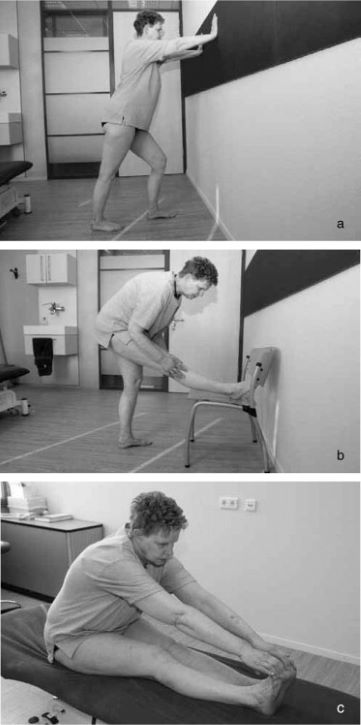
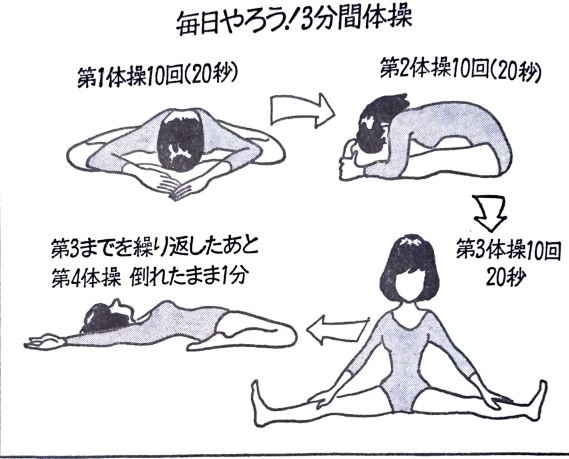
So far, I have done these stretches before sleep for about a week. It works, I think.
1) episodic: 時折起こる
2) hamstring: 人間のひざの後ろの腱
3) palpation: 触診
4) benign: [bɪnάɪn] 良性の
5) substantial: plentiful 相当な
6) distress: suffering 苦悩
7) disrupt: 中断する
8) insults: 発作
9) prevalent: はやっている
10) comorbidity: 共存症
11) neurological: 神経性の
12) cardiovascular: 循環器系の
In adults who experience nocturnal leg cramps, does stretching of the calf and hamstring muscles each day just before sleep reduce the frequency and severity of the cramps?
A randomised trial with concealed13) allocation14) and intention-to-treat analysis15).
13) concealed: 隠した
14) allocation: 割り当て、配置
15) intention-to-treat: ITT分析、包括解析
Eighty adults aged over 55 years with nocturnal leg cramps who were not being treated with quinine16).
16) quinine: kwάɪnɑɪn(米国英語), kwɪníːn(英国英語)、キニーネ剤(マラリア特効薬)
The experimental group performed stretches of the calf and hamstring muscles nightly, immediately before going to sleep, for six weeks. The control group18) performed no specific stretching exercises. Both groups continued other usual activities.
17) intervention: 治療介入
18) control group: 操作を加えないままにしてあるグループ
Participants recorded the frequency of nocturnal leg cramps in a daily diary. Participants also recorded the severity of the pain associated with nocturnal leg cramps on a 10-cm visual analogue scale. Adverse events were also recorded.
All participants completed the study. At six weeks, the frequency of nocturnal leg cramps decreased significantly more in the experimental group, mean difference 1.2 cramps per night, (95% CI19) 0.6 to 1.8). The severity of the nocturnal leg cramps had also decreased significantly more in the experimental group than in the control group, mean difference20) 1.3 cm (95% CI 0.9 to 1.7) on the 10-cm visual analogue scale.
19) 95% CI: 95%confidence interval 95%信頼区間20) mean difference: 治療群の数値の平均値とコントロール群の数値の平均値の差
Nightly stretching before going to sleep reduces the frequency and severity of nocturnal leg cramps in older adults.
Trial registration
NCT01421628
*
(547) 9/11 in 2001 [読解]

THE DAILY YOMIURI
2 planes crash into World Trade Center
NEW YORKーPlanes crashed into the upper floors of both World Trade Center towers minutes apart Tuesday in a horrific3) scene of explosions and fires that razed4) one of the 110-story towers and left gaping5) holes in the other.
1) plow into: ・・・と衝突する、to move forcefully into or through something
2) evacuate: 避難させる、to remove especially from a dangerous area
3) horrific: ぞっとする
4) raze: ・・・を倒壊させる、to destroy to the ground
5) gap: すき間ができる、to fall or stand open
6) fatality: 死亡者
President George W. Bush said Tuesday that the crashes were "an apparent terrorist attack on9) our country."
7) DFLP: Democratic Front for the Liberation of Palestine, パレスチナ解放民主戦線
8) claim responsibility for: 犯行声明を出す、to assert to be rightfully one's own
9) attack on: (武力による)攻撃、襲撃
10) somber: 深刻な、暗たんたる、of a dismal or depressing character
In Washington, officials said the FBI was investigating reports of a plane hijacking11) before the crashes.
11) hijack: ハイジャックする、to commandeer (a flying airplane) especially by coercing the pilot at gunpoint
12) on condition of anonymity: 匿名を条件に
13) suicide mission: 自爆任務、killing or injuring others while annihilating yourself
14) preliminary: 予備の、準備の、coming before and usually forming a necessary prelude to something else
The towers were struck by bombers15) in February 1993.
15) bomber: 爆撃機
16) at a slight angle: わずかな角度で
17) landmark: a structure (such as a building) of unusual historical and usually aesthetic interest
18) a sonic boom: 衝撃音波
19) debris: 瓦礫、remains of something destroyed
20) leaflet: pamphlet
21) be on fire: 燃えている
22) obscure: 不明瞭な、dim and hazy
23) come drifting: 吹き積る
In 1945, an Army Air Corps B-25, a twin-engine bomber, crashed into the 76th floor of the Empire State Building in dense fog.
A senior government official, speaking on condition of anonymity, said that agency is pursuing reports that one or both of the planes were hijacked and that the crashes may have been the result of a suicide mission.
The source stressed that the reports are preliminary and officials do not know the cause of the crashes.
"It certainly doesn't look like an accident," said a second government official, also speaking on condition of anonymity.
Asked what he knew about the planes, Bush replied, "I'll talk about it later."
The New York Stock Exchange, located in lower Manhattan near the trade center where many financial offices are kept, indefinitely24) suspended trading.
24) indefinitely: 不明確に、 not defining or identifying
Right: Smoke and fire pour from the upper floors of World Trade Center in New York city after the second airplane hit the tower.
WASHINGTON ー The Pentagon was evacuated Tuesday after a plane crashed into the building, following an apparent terrorist attack on the World Trade Center in New York, officials said.
Pentagon officials ordered employees out of the building just outside Washington.
The West Wing of the White House was also evacuated amid terrorist threats.


The 9/11 Tribute Museum, formerly known as the 9/11 Tribute Center and Tribute WTC

*
(545) Twenty Months in Japan / 1. Pacific Royal steamship "Empress of Japan" [読解]
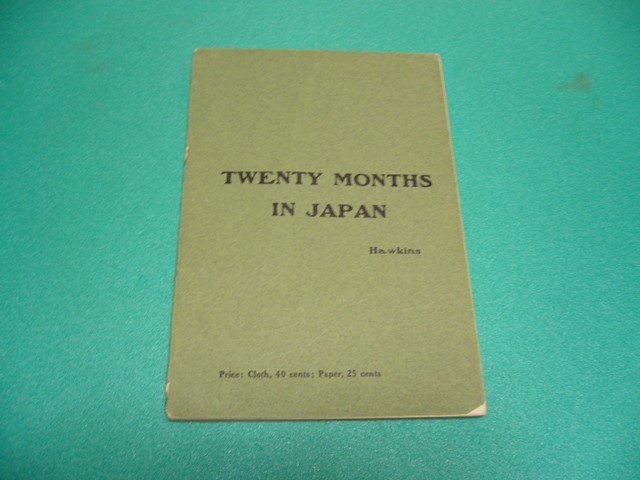
TWENTY MONTHS IN JAPAN (松山 明治25年~27年、1892~1894)
/ by Henry G. Hawkins, Publishing House of the M.E. Church, South / 86p., 19 cm
In 1892 he became an English instructor in the Japanese Government Middle School at Matsuyama (松山尋常中学校), after which he wrote a booklet titled "Twenty Months in Japan.
20s.jpg)
Name: Empress of Japan
Owner: Canadian Pacific Steamship Company
Years of service: 1890 - 1922
Type: Ocean liner
Tonnage: 5,905 tons
Length: 456 ft (139 m)
Beam: 51 ft (16 m)
Propulsion: twin propellers
Speed: 16 knots
Capacity: 160 1st passengers
40 2nd class
Up to 700-sterage passengers
1. PACIFIC ROYAL STEAMSHIP "EMPRESS OF JAPAN"
1) viands: piece of food
2) lounge: ゆったりと横になる
3) have a place: ・・・のための場所がある
4) berth: a place to sit or sleep especially on a ship or vehicle, 寝台
5) fog horn: warning horn sounded in a fog, 霧笛
6) at the mercy of: ・・・のなすがままに(なって)
7) mariner: 水夫
8) make the acquaintance of: ・・・と知り合いになる
9) customhouse official: 税関の役人
10) band stand: 野外ステージ

This evening for tomorrow morning I expect to see land for the first time in twelve days. We will be at Yokohama twenty-four hours, then go by the same steamer to Kobe, remaining there for passports. It is turning warm fast. Excepting two or three days spent about Vancouver, the weather has required overcoats for the open air ever since leaving Winnipeg, until yesterday. At Victoria the ship stopped on night: since then, the sailing has been uninterrupted at the rate of nearly fifteen miles an hour. The sights have been a few whales spouting12) in the distance; two far-off vessels on the Bering Sea, thought to be provision13) carries; a few sea gulls searching for any food that may fall from the ship; several dense fogs, requiring a horn to be blown about every five minutes; many clouds; an occasional sun or moon, revealing a vast expanse of water, most of the time greatly waving, and last Sunday tossing the ship from side to side, so that the captain ordered, "No services14)." He had prviously arranged for a Rev. Dr. Vincent, M.A.15), LL. D.16), to read the service a la Anglaise17), and for Bishop Key to preach.
11) far-off: 遠くの
12) provision: 食料
13) service: 集会礼拝
14) M.A.: Master of Arts. 文学修士
15) LLD: Legum Doctor(=Doctor of Laws)法学博士
16) a la Anglaise: 音節à l'an • glaise 発音ɑː lɑːŋɡléiz, æ 英国流の
17) a game of cricket: クリケットの試合
18) sumptuous: 豪華な
19) fare: (食卓に出された)食物
20) mostly: 主に、主として
21) throng: 人だかり、大勢;多数
22) a sight: 見もの;物笑い(の種)、ひどい有様だ。
幾つかのささやかな娯楽に加えて、午後になるといつも、屋外ではクリケットのゲームが行われた、ボールはネットで外へ飛び出さないようになっている。中国人は使用人として働いている。乗組員を構成しているのはイギリス人だった。料理長はフランス人である。毎日印刷される昼食会のリストを一目見れば、豪華な料理のことがわかった。昨夜、一部の乗客と一等航海士達によってコンサートが開かれた。長い髪(辮髪)、箸、夢中になって賭け事をしている、主に中国人の人だかりは見ものである。
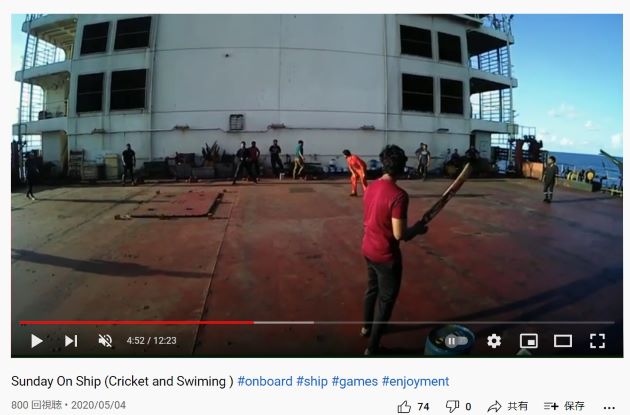
(Even now, a game of cricket on sea seems to be very popular.)
Save threatened seasickness once or twice, my health has been good. We have a fine, large, well-managed ship, with many of the conveniences of modern civilized life; but I cannot say that I like water travel as well as land. The tossing in not pleasant. We have not had much of it, but one lady gave up the second day, and has not been of23) her state-room24) since. They say that every ship has a peculiar odor; and I thought they are scrubbing and painting in25) this one all the time, it has in same places a very distinct odor that certainly cannot be counted26) among the luxurious of travel.
23) be of; ~の出
24) state-room: (客船、列車の) 個室、特別室
25) paint in: を書き[描き] 加える
26) count: を・・・と考える、思う
*
(541) Twenty months in Japan / Nanamagari [読解]
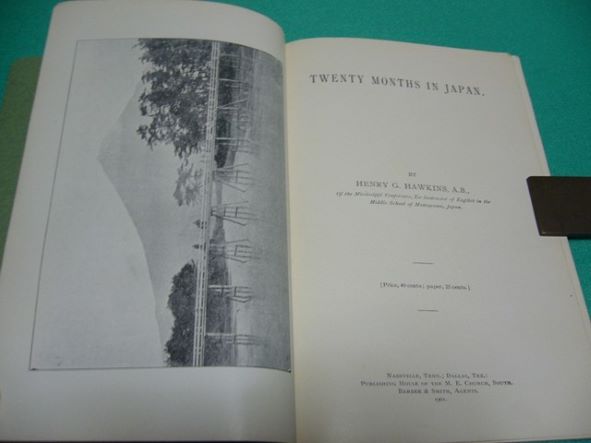
Biography
Henry Gabriel Hawkins was born on October 5, 1866, in Choctaw County Alabama. In 1892 he became an English instructor in the Japanese Government Middle School at Matsuyama(松山尋常中学校), after which he wrote a booklet titled "Twenty Months in Japan."
Walking to the castle


The principal hall upon the ground floor (Cellar のことかな?) is where the occupants were to go and kill themselves in case of defeat, coming down by means of a rude elevator (明治時代は米蔵から一階への階段はついていなかったか?) from the halls above. You may ascend to those halls by a stairway in another part of the structure; (Entrance Hallのことかな?) and from the height reached you may look at the surrounding city, the sea, islands, fields, distant villages, and mountains. There is the road to the sea, with seven abrupt turns (七曲りNanamagari) made it, so that the number of the enemy coming could be very well judged from the way they filled these parts of the road.
http://haisentn.blog41.fc2.com/blog-entry-59.html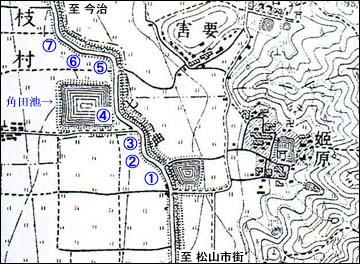
昭和7年鉄道補入「松山北部」(1:25,000地形図)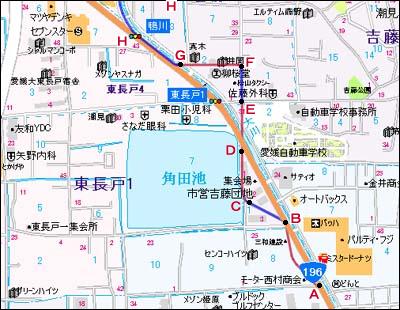
現在
Kato Yashiakira, (嘉明 Yoshiakira) who had been general under Hideyoshi, the Napoleon of Japan, founded the castle about three hundred years ago. It was rebuilt forty-nine years ago, (1854年にrebuiltだから49年プラスで1903, Hawkinsは1892に在松山なので、ちょっと合わない?) and of the original wooden portion only the first great gateway remains. (筒井門 Tsusui-mon gateのことかな?)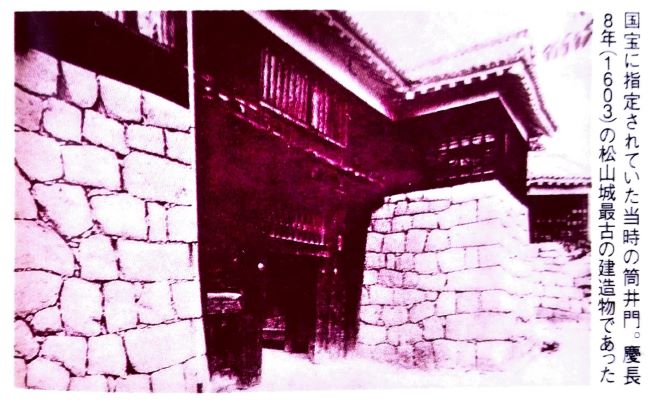
There is nothing fine in the structure; but considering the great quantities of granite1) used, the cost must have been a million dollars. It is not in service at all at present. Though a regiment2) of soldiers located here now have modernized barracks at the mountain base, the deserted condition of the castle, and the sight of piles of sharp swords and spears begging for purchasers as one passes in front of the numerous second-hand shops, make us believe that the world is going toward the fulfillment of Isaiah's words; "And they shall beat their swords into plowshares, and their spears into pruning hooks, nation shall not lift up sword against nation, neither shall they learn war any more."3)
1) granite: 花崗岩、御影石
2) regiment: 連隊、 a millitary unit consisting usually of a number of battalions
3) Isaiah 2:4 New Living Translation:
The Lord will meditate between nations and will settle international disputes. They will hammer their swords into plowshares and their spears into pruning hooks. Nation will no longer fight against nation, nor train for war anymore.
*
(538) The Aizu castle siege [読解]
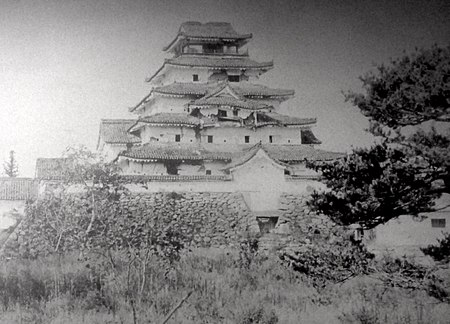
Aizu castle just after surrender. From Wikipedia.

The History of Modern Japanese Education: Constructing the National School System, 1872-1890
- 作者: Duke, Benjamin
- 出版社/メーカー: Rutgers Univ Pr
- 発売日: 2014/03/14
- メディア: ペーパーバック
Sutematsu's personal account of the Aizu castle siege.
We women and children were divided into bands1) of workers, those who washed and cooked the rice, those who did the housework, and those who made the ammunition2) for the men at the front. I was too young to be trusted with the making of cartridges3), so the work alloted me was to bring the leaden balls4) from the storehouses, and after they had been made up into cartridges to carry them back to another storehouse, whence5) they were sent to the men..... The last month of the siege, the imperial troops planted guns on the hills around us, and not a day passed when cannon-balls did not whiz6) over our heads, dropping into the castle and crushing into the keep7) itself. It was then part of my work to roll them together in piles, out of the way. My mother, sister, sister-in-law and I expected death at any minute but none of us liked the idea of being mutilated instead of killed outright8). So we made our mother promise that if any of us should be mortally wounded she wounded she would cut off our heads in true samurai fashion. A few days after this, while we were snatching9) a mouthful of food, a shell10) fell into the room, and bursting, wounded my sister-in-law in the breast and me in the neck. My wound was nothing to speak of, and I was up and at work again at the end of the week. It was different with my sister-in-law. We saw that she must die.... Strange as it may seem, my future husband was one of the attacking forces and was swounded during the night assault. Little did I dream that I should be the wife of one of the enemies whose cannon-balls I so carefully rolled into heaps.
2) ammunition: objects that can be shot from a weapon, such as bullets or bombs
3) cartridges: a case of containing an explosive charge for blasting
4) leaden balls: balls made of lead
5) whence: from or out of which place, source, or cause
7) keep: the strongest and securest part of a medieval castle
8) outright: immediately
9) snatch: to take or have something quickly using the only time or chance that you have
10) shell: a projectile for cannon containing an explosive bursting charge
At the time of the castle siege11) in 1868, Sutematsu was eight years old. Her personal account12) of the episode, recollected13) as an adult in Japan and composed in English, sgands as tribute14) to her courage as well as the education she received in the United States. It is surely the only recorded account originally in English by a Japanese who was on the scene of a castle siege in feudal Japan.
11) siege: a situation in which an army surrounds a town for a long time so that nobody can get in or out
12) account: somebody's report or description of something that has happened
13) recollect: to remember something especially by making an effort
14) tribute: something that you say or do to show that you respect or admire somebody/something, especially somebody who has died
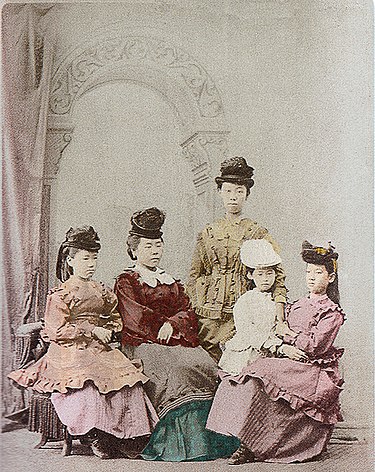
新政府の米国留学女学生 左から、永井しげ(10)、上田てい(16)、吉益りょう(16)、津田うめ(9)、山川捨松(12)。明治4年。姓名はいずれも当時のもの、数字は数え歳 From left, Nagai Shige (10), Ueda Tei (16), Yshimasu Ryo (16), Tsuda Ume (9), Yamakawa Sutematsu (12), in 1871.
In 1871 Sutematsu's brother Hiroshi, responsible for the family and the Aizu clan in exile, learned of Kuroda's plan to send young girls abroad for a modern education to promote the development of Hokkaido. Apparently concerned over the future of his sister, Hiroshi submitted an application to the Frontier Bureau on behalf of Sutematsu. With only five applicants, the bureau approved Sutematsu's candidacy along with the other four. The girls departed with the Iwakura Mission on December 21, 1871, on the steamer America amid a colorful ceremony with a fanfare of gun salvos.
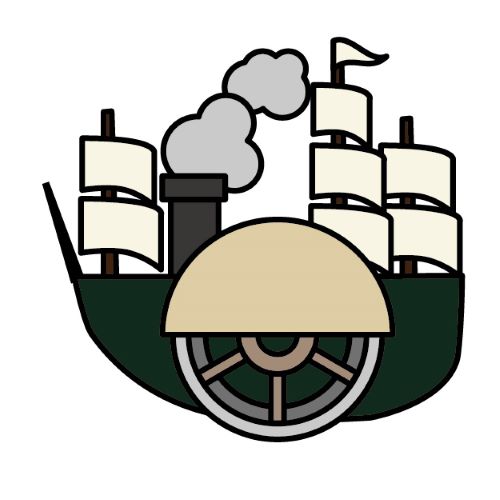 外輪船、Paddle-wheel steamer
外輪船、Paddle-wheel steamer*
(505) Handmade puzzles at home [読解]
This puzzle was invented by the American Sam Loyd in 1898. It was printed on two pieces of card and sold more than 10 million copies.
You'll find when the discs are set one way there are 13 characters, but when they move, one of the people disappears!
http://www.murderousmaths.co.uk/games/getofftheearth.htm
Ⅰ. There are 13 Chinese Swordsmen in this picture around the earth.
Ⅱ. A small disk and a large disk can rotate separately.
The earth (a small disk) rotates anti-clockwise a litter, so each character’s parts are separated. 
Ⅲ. The earth disk stops at 30 degrees rotated position.
Each swordsman’s parts meet together and we can see 12 complete swordsmen. Wow! One swordsman disappears.
I found this picture on the internet. Then I made “Get off the earth” puzzles myself by using several rotating mechanisms.

http://www.tokyomagic.jp/labyrinth/kiga/tanoshii-zukei-puzzle-01.htm
SAM LOYD the famous inventor of puzzles, often referred to as the most expert mechanic living, is the author of this wonderful “Get Off the Earth “ Puzzle. In a recent letter to the press Mr. Loyd says: “This puzzle may strike the average mortal1) as being a “bland2) and childlike” toy. Nevertheless, just for my own satisfaction, I offer six first class Bicycles to such as3) send the best answers to the mystery during the present year. I select the Columbia Bicycles, because from a mechanical and engineering stand point I consider them superior to all other.
Sam Loyd, P.O.Box 1821, New York.
The Sam Loyd Get Off The Earth Puzzle
1) mortal : a human being 人間
2) bland : tasteless 平凡な
3) such as : 〜してくれる人達
此人時常到佢要来収銀 (This person often comes to collect cash.)
此人出去了佢係欠你銀 (This person went out to owe you money.)
Here are my handmade “Get Off The Earth” puzzles.
By using a shallow, round and disposable lunchbox of sushi.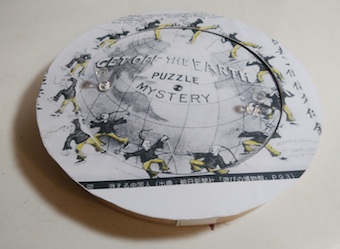
By using music CDs and its case.
By using a music CD case.
By using laminated sheets.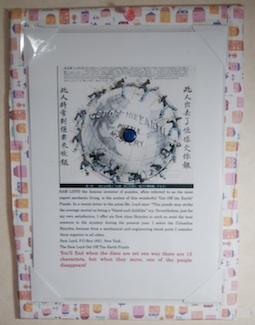
*
(504) Pasta at home [読解]

My Farfalle Cacio e Pepe
Canestri1) Cacio e Pepe2) Recipe
1) canestri : canestri : a traditional Italian pasta shape that sort of looks like a little basket.
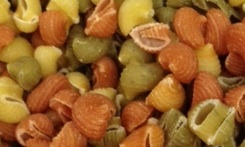
anestri basil garlic tomato
2) cacio e pepe : "cheese and pepper" in Italian
(serve 4 as a ,main course. 6 as an appetizer)
Tools: a large pan wide enough to hold the pasta, a small pan, and tongs3)
3) tongs : grasping device of 2 joined or hinged pieces
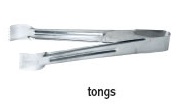
Ingredients
1 lb4) dried canestri or lumache5) pasta
(feel free to substitute shells, bowties6), or other short pasta shapes in you pantry7))
1 1/3 table spoon freshly ground black pepper – not too fine!
10 tablespoon unsalted butter, split in half evenly
2 cups freshly ground grana padano8) or high quality parmesan9) cheese
3 cups pasta water10)
4) lb : 0.45 kilograms
5) lumache : Lumac(h)oni are a type of snail-shaped Italian pasta. Larger than pipe (brand: Panzani).

6) bowties pasta : farfalle / farfalle are a type of ribbon-cut, folded pasta

7) pantry : storage room for food and dishes, 食料品室、食器室
8) grana padano : Grana Padano is a cheese originating in the Po river Valley in northern Italy, hard, crumbly-textured cheese.
9) parmesan : parmesan cheese / Parmesan産の味が濃い固いチーズ
10) pasta water : パスタのゆで汁
Method
Bring 4 quarts11) water to a boil12). Season with salt; add pasta and cook stirring occasionally, until about 1 minute before tender. Drain, reserving 3 cups pasta cooking water. You don’t want to pull13) the pasta water too early! Wait until the pasta is ready, as it will ensure the water’s maximum starchiness14). The starches in the pasta water will ultimately stabilize the emulsification15) between the cheese and butter, which creates magic.
11) quarts : 0.95 liters
12) boil : bring water to a boil / 水を沸騰させる
13) pull : to come into possession of
14) starchiness : nourishing carbohydrate from plants also used in adhesives and laundering / デンプン
15) emulsification : converting into an emulsion / 乳化
Meanwhile, toast black pepper in a large heavy DRY skillet16) over medium heat. Swirl17) pan frequently, until pepper is toasted, about 45 seconds to 1 minute. You will know the pepper is sufficiently toasted when the aroma of black pepper fills your kitchen. Watch out for the sneezes!
16) skillet : pan for frying
17) swirl : to move swiftly in circles, eddies, or undulations
Add 5 tablespoons of butter to the pan with the pepper. It will quickly melt. Working fast to avoid burning the butter, add 2.5 cups reserved pasta water to skillet and bring to a rapid simmer18). Please be careful when you add the pasta water to the pan, as it may splatter a bit – it will burn you! Reduce volume by almost half (this will take a couple of minutes), then add pasta. Cook pasta for the remaining minute, reduce heat to very low and quickly add remaining 5 tablespoons of butter and the cheese, stirring and tossing19) vigorously with tongs until cheese is melted.
18) simmer : 煮詰め /bring to a rapid simmer急速に煮る
19) tossing : toss/ move to and fro or up and down
Remove pan from heat and continue tossing until the sauce is smooth, emulsified, and coats the pasta. (Add some of the remaining 0.5 cups pasta water if sauce seems dry.) Transfer to a large bowl, garnish20) with more cheese if desired and enjoy.
20) garnish : add decoration to (as food) /<料理>に[・・・を]添える[with]
*
(503) 原文Rebus / The Hunter and The Squirrel. [読解]

http://www.jwstelly.org/CyclopediaOfPuzzles/PuzzlePage.php?puzzleid=Pz61.2#Pz61.2
The Hunter and The Squirrel.
Here is the old problem of the hunter who saw a squirrel on a tree and tries to get a good shot at it, but the squirrel cleverly manages to keep always on the opposite side. The hunter, as shown by the tracks in the snow, has gone around the tree so as to make a complete circle, but the squirrel has also gone around the tree, keeping on the opposite side, and we wish to know has the hunter walked around the squirrel? I give the problem because puzzlists1) from all parts of the world have asked me to give my answer to the problem.
(1) puzzlist / One who enjoys creating or solving puzzles
A thousand and one2) subtle arguments have been offered to prove that the man does not go around the squirrel, principally based upon Webster’s definition that around is, on all sides of; encircling, encompassing.
2) a thousand and one / A great many; numerous.
I claim that the man has most positively gone around the squirrel, just as the rim of a wheel goes around the hub which turns on the axle; just as the earth goes around the sun, which has a lesser orbit proportional to their difference in weight.
I remember going all around a field once, but a cross dog faced me all the time so I could not reach the apple tree; but I went all around that field and all that3) was in it. I wished at the time that I was big enough to take that dog by the tail and swing him around, but perhaps some philosopher would tell me that the dog was not being swung around, because he always had the same end toward me.
3) and all that /…やら何やら, (および)…など.
One of the same professors who maintain4) it is impossible to go around the earth unless the earth stops turning, places implicit5) faith in the old snake story. He says a snake can always swallow a snake of its same size; he once placed two four foot snakes together in a cage, and each seized the others tail and began to swallow it at the same time, so they both disappeared simultaneously. He asked Sammy to illustrate it upon the blackboard, and Sammy, who was quite a little artist, drew the following picture:
4) maintain / to uphold as true, right, proper, or acceptable often in the face of challenge or indifference
5) implicit / complete and unquestioning
Answer
Sammy’s Rebus in the story of the hunter and the squirrel say: “No body believes a liar.”



